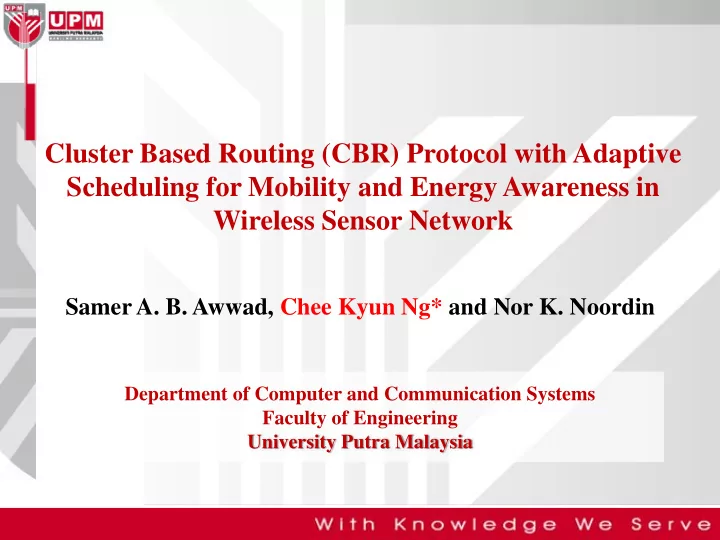

Cluster Based Routing (CBR) Protocol with Adaptive Scheduling for Mobility and Energy Awareness in Wireless Sensor Network Samer A. B. Awwad, Chee Kyun Ng* and Nor K. Noordin Department of Computer and Communication Systems Faculty of Engineering University Putra Malaysia
Wireless Sensor Network � The WSN consists of a large number of randomly distributed sensor nodes that are densely deployed either inside a phenomenon or around it. � The WSN consists of the following components: o Sensor nodes. o Sensor field. o Event. o Sink node. o Observer node.
Mobility in WSN � WSN sensor nodes trend to be mobile. � Some applications like habitat Battlefield monitoring, wildlife (animal) monitoring tracking, health care monitoring, and search and rescue call for mobile sensor. Health care Wildlife monitoring monitoring
Problem Statement � Mobility has only recently been introduced in WSN. It is becoming increasingly useful in a variety of applications. � In static WSNs, the research community generally ignores the mobility of sensor nodes. Some protocols to support mobility have been proposed: o Mobility Adaptive Hybrid MAC (MH-MAC) protocol � but mobility information beacon message overhead. o Low Energy Adaptive Clustering Hierarchy (LEACH) protocol � but relies on weighing k-density, residual energy and mobility parameters in the cluster head election. o LEACH-Mobile protocol � but it needs membership declaration o LEACH-Mobile Enhanced (LEACH-ME) protocol � but minimum mobility factor is elected as cluster head
Cluster Based Routing for Mobile Nodes (CBR-Mobile) Protocol o Mobility and traffic adaptive. � Cluster heads adaptively reassigning the timeslots according to sensor nodes mobility and traffic. o Two owners are created for each timeslot � Original owner and alternative owner. This protocol keeps the new mobile sensor nodes in the simple database tables and serves these nodes whenever the free or unused timeslot is available.
Mobility and Traffic Adaptive Mobility Traffic � The timeslots assigned to the � The timeslots assigned to the sensor mobile sensor nodes that moved nodes that have no data to send Sensors have no out of the cluster remain waste. remain waste. data N1 N2 N3 N4 N5 N6 N7 N1 N2 N1 N3 N4 N3 N5 N6 N7 N7 N4 N1 N1 N1 N4 N5 N5 N3 N3 N3 N6 N6 N2 N2 N7 N7 N7 Cluster 1 Cluster 2
Two Simple Databases � Exploits these two groups of unused timeslots to support sensor nodes mobility � two simple database (tables) : � Alternative Schedule Database (ALT_SCH) . � Membership Requesters Database (NEW_MEM_REQs). Original N1 N2 N3 N4 N5 N6 N7 N8 N9 N10 Schedule ALT_SCH N10 N9 N8 N7 N6 N5 N4 N3 N2 N1 Old Cluster New cluster NEW_MEM_RE Qs MSN Sensor ID 1 CH MSN1
Simulation Scenario Parameter and Value Models CH Channel bandwidth 40 Kbps CH Network (field) Size (L*W) 50* 50 m 50 Number of Sensor Nodes 100 CH Location of the Sink Node (25,25) Simulation Size 12K + CH CH Maximum Transmission R 19 m Percentage of Cluster Head 5 % 50 Percentage of Mobile Sensor 0 – 90 % Parameter Value Data Size 2000 bits TOUT2_DATA_REQ 0.014984000040001 Random Way Point speed Mobility Model Timeslot 0.166128550180004 (1-10) m/s Traffic Model CBR and Poisson Radio Model Two-Ray Ground model Queuing Model FIFO with Drop Tail NEW_MEM_REQs Initially is empty Idle Power 2.4 mW Battery Initial const(13,000J) Rx Power 67.2 mW Sensor Nodes Deployment Random Deployment Tx Power 76.8 mW TOUT_DATA 0.007392100040001 Sleep Power 0.0048 mW TOUT_DATA_REQ (0-0.007392100020001)
Evaluation Metrics Number of Received Packets at Sink Node � Packet Delivery Ratio = Number of Generated Packets at Sensor Nodes Total Energy Consumption � Average Energy consumption [J] = Total number of received packets Total Energy consumption [J] = Total Packet Delay � Average Delay [s] = Total number of received packets Total Packet Delay [s] =
Packet Delivery versus Percentage of Mobile Sensor Nodes 43% CBR-Mobile applies The disconnection period of mobile sensor for CBR- additional overhead Mobile is shorter than the LEACH-Mobile one
Average Energy Consumption versus Percentage of Mobile Sensor Nodes 16%
Packet Delivery Ratio versus Generated Traffic in Static & Mobility Environments 13 % 30 % 30 % 0.19 0.27 0.25 In static environment, LEACH-Mobile maintains the steady state situation to 0.27 Packet Delivery Ratio for LEACH-Mobile drops by 30 % in mobility environment In static environment, CBR-Mobile maintains the steady state situation to 0.25, LEACH-Mobile shortens the life of steady state situation by 30 %, while CBR- compared to static one, while it drops by 13 % for CBR-Mobile. Pkt/s, while it drops to 0.19 Pkt/s in mobility environment. and keep the same value in mobility environment. Mobile maintains the same steady state situation.
Average Delay versus Generated Traffic for CBR and Poisson Traffic types Poisson CBR Traffic Traffic 13 % 30 % 47 % CBR-Mobile achieves less average delay for both CBR and poisson traffic. It has the advantage of 30 % less average delay for CBR traffic and 13-47 % for the Poisson one.
Conclusions A mobility and traffic adaptive cluster based routing has been designed to support sensor nodes mobility in WSN. The protocol improve the packet delivery ratio and decrease the energy consumption. By reusing the unused timeslots, mobile sensor nodes can rejoin the network within short time and considerable increment in packet delivery ratio can be obtained. This can be achieved by mobility-, and traffic-adaptive scheduling.
Samer A. B. Awwad, Chee Kyun Ng samer_awwad80@yahoo.com, mpnck@ eng.upm.edu.my
Recommend
More recommend